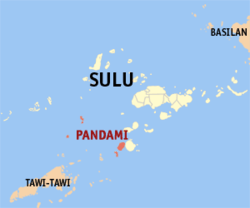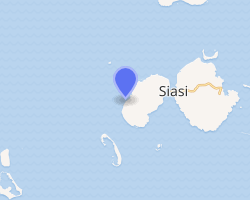Pandami
Pandami, officially the Municipality of Pandami (Tausūg: Dāira sin Pandami; Tagalog: Bayan ng Pandami), is a 4th class municipality in the province of Sulu, Philippines. According to the 2015 census, it has a population of 25,885 people.[3]
Pandami | |
|---|---|
| Municipality of Pandami | |
 Map of Sulu with Pandami highlighted | |
OpenStreetMap 
| |
.svg.png) Pandami Location within the Philippines | |
| Coordinates: 5°32′N 120°45′E | |
| Country | |
| Region | Bangsamoro Autonomous Region in Muslim Mindanao (BARMM) |
| Province | Sulu |
| District | 2nd District |
| Barangays | 16 (see Barangays) |
| Government | |
| • Type | Sangguniang Bayan |
| • Mayor | Nurhan S. Berto |
| • Vice Mayor | Rakib P. Pulahong |
| • Congressman | Munir M. Arbison |
| • Electorate | 15,660 voters (2019) |
| Area | |
| • Total | 170.89 km2 (65.98 sq mi) |
| Population (2015 census)[3] | |
| • Total | 25,885 |
| • Density | 150/km2 (390/sq mi) |
| • Households | 4,870 |
| Economy | |
| • Income class | 4th municipal income class |
| • Poverty incidence | 49.19% (2015)[4] |
| • Revenue (₱) | 74,609,252.09 (2016) |
| Time zone | UTC+8 (PST) |
| ZIP code | 7400 |
| PSGC | |
| IDD : area code | +63 (0)68 |
| Climate type | tropical climate |
| Native languages | Tausug Tagalog |
Barangays
Pandami is politically subdivided into 16 barangays.
- Baligtang
- Bud Sibaud
- Hambilan
- Kabbon
- Lahi
- Lapak
- Laud Sibaud
- Malanta
- Mamanok
- North Manubul
- Parian Dakula
- Sibaud Proper
- Siganggang
- South Manubul
- Suba-suba
- Tenga Manubul
Climate
| Climate data for Pandami, Sulu | |||||||||||||
|---|---|---|---|---|---|---|---|---|---|---|---|---|---|
| Month | Jan | Feb | Mar | Apr | May | Jun | Jul | Aug | Sep | Oct | Nov | Dec | Year |
| Average high °C (°F) | 27 (81) |
27 (81) |
27 (81) |
28 (82) |
28 (82) |
28 (82) |
28 (82) |
28 (82) |
28 (82) |
28 (82) |
28 (82) |
27 (81) |
28 (82) |
| Average low °C (°F) | 26 (79) |
26 (79) |
26 (79) |
27 (81) |
27 (81) |
27 (81) |
27 (81) |
27 (81) |
27 (81) |
27 (81) |
27 (81) |
27 (81) |
27 (81) |
| Average precipitation mm (inches) | 184 (7.2) |
143 (5.6) |
144 (5.7) |
136 (5.4) |
240 (9.4) |
301 (11.9) |
272 (10.7) |
253 (10.0) |
183 (7.2) |
265 (10.4) |
246 (9.7) |
208 (8.2) |
2,575 (101.4) |
| Average rainy days | 18.6 | 15.8 | 16.9 | 15.7 | 23.3 | 24.2 | 24.6 | 23.2 | 20.5 | 23.0 | 22.2 | 20.4 | 248.4 |
| Source: Meteoblue [5] | |||||||||||||
Demographics
| Year | Pop. | ±% p.a. |
|---|---|---|
| 1990 | 17,159 | — |
| 1995 | 18,181 | +1.09% |
| 2000 | 19,964 | +2.03% |
| 2007 | 23,527 | +2.29% |
| 2010 | 22,474 | −1.65% |
| 2015 | 25,885 | +2.73% |
| Source: Philippine Statistics Authority[3][6][7][8] | ||
gollark: Γρεεκ Ις Φυν!
gollark: why would I know? I can write/read ancient Greek, not Japanese.
gollark: \▫
gollark: \㊙
gollark: \💯💯
References
- "Municipality". Quezon City, Philippines: Department of the Interior and Local Government. Retrieved 31 May 2013.
- "Province: Sulu". PSGC Interactive. Quezon City, Philippines: Philippine Statistics Authority. Retrieved 12 November 2016.
- Census of Population (2015). "ARMM – Autonomous Region in Muslim Mindanao". Total Population by Province, City, Municipality and Barangay. PSA. Retrieved 20 June 2016.
- "PSA releases the 2015 Municipal and City Level Poverty Estimates". Quezon City, Philippines. Retrieved 12 October 2019.
- "Pandami, Sulu : Average Temperatures and Rainfall". Meteoblue. Retrieved 31 January 2019.
- Census of Population and Housing (2010). "ARMM – Autonomous Region in Muslim Mindanao". Total Population by Province, City, Municipality and Barangay. NSO. Retrieved 29 June 2016.
- Censuses of Population (1903–2007). "ARMM – Autonomous Region in Muslim Mindanao". Table 1. Population Enumerated in Various Censuses by Province/Highly Urbanized City: 1903 to 2007. NSO.
- "Province of Sulu". Municipality Population Data. Local Water Utilities Administration Research Division. Retrieved 17 December 2016.
External links
- Pandami Profile at PhilAtlas.com
- Philippine Standard Geographic Code
- Philippine Census Information
- Local Governance Performance Management System
This article is issued from Wikipedia. The text is licensed under Creative Commons - Attribution - Sharealike. Additional terms may apply for the media files.